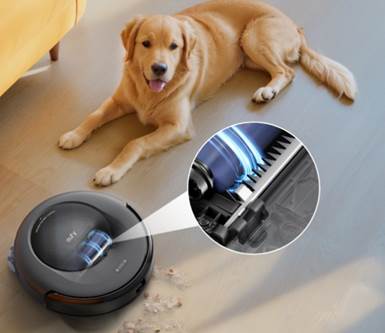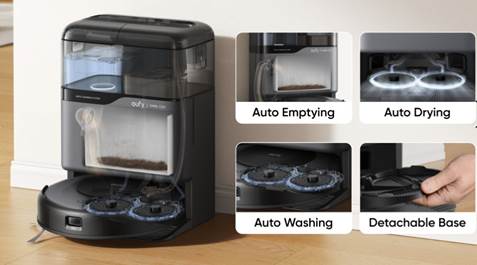Understanding your home's
architecture and cleaning requirements can help you choose a robot vacuum.
Mismatches degrade performance and cost money. Small flats do not require as
much power or features as larger homes. Choosing between dozens of models may
be tough. Size, suction, smart features, and runtime all matter. A studio or
multi-story house model will meet your demands. This article will assist you in
determining the best robot vacuum for your home's size, demands, and available
space.

What Should You Consider Before Buying a Robot Vacuum?
Assess Your Home’s Size and Floor Plan
Measure your dwelling area before you make a purchase.
Small areas are easier to clean and do not necessitate extensive mapping.
Larger homes may have several rooms and various flooring types, necessitating a
smarter, more powerful robot. Most vacuums work well in open floor plans, but
complex layouts with multiple rooms or halls necessitate robots with multi-room
mapping and navigation capabilities. A clear understanding of your space
ensures that you do not underbuy or overspend. Consider future needs as well—if
you intend to relocate to a larger home, it may be prudent to invest in a model
that can scale with you.
Identify Floor Type and Obstacles
You don't need a heavy suction if your home is mostly
hardwood or tile. Homes with carpets, especially thick piles, require stronger
motors. Additionally, consider the height of your furniture and clutter. While
some robots can maneuver through tight spaces, others become stuck. Pet toys,
cables, and furniture legs can be obstacles. Select a vacuum with sensors that
adjust to different surfaces and avoid tangling. Pet owners will particularly
benefit from obstacle detection. Mapping technology helps prevent frequent
collisions. Matching vacuum capabilities with your flooring and layout prevents
everyday annoyances.
Understand Your Cleaning Needs and Frequency
Think about how often you need to clean and what kind
of debris you’re working with. Households with kids or pets will require
regular vacuuming. Look for models with strong suction and big dustbins.
Allergy suffers should consider models with HEPA filters. If you prefer a
set-it-and-forget-it method, opt for a vacuum with scheduled cleaning and
auto-emptying. Homes that stay pretty clean can use budget-friendly,
low-maintenance units. The amount of noise also matters. Some robots are
quieter and better for daytime use. Figuring out what you do every day will
help you find the best robot vacuum for your needs.

How Do Battery Life and Charging Time Affect Performance?
Runtime and Charging Basics
Battery life determines how much ground a robot can
traverse in a single session. Most models provide between 60 and 120 minutes of
runtime. For tiny settings, a 60-minute battery may be sufficient. However,
runtime requirements grow with square footage and clutter. Charging time
normally ranges between 3 and 5 hours. Fast-charging variants are beneficial
for numerous daily cleanings. Always match the runtime to the home size and
layout. Avoid overpaying for high battery life if your space does not demand it.
The finest robot vacuum balances runtime and charge time to provide consistent
results with fewer disruptions.
Docking Stations and Auto-Resume Options
Docking stations are more than just charging stations;
they also serve as command centers. Some types automatically empty dustbins,
while others only recharge. Auto-resume technology is an essential feature for
homes larger than 1,000 square feet. If the battery runs out during cleaning,
the robot recharges and resumes where it left off. Without this, enormous
regions may remain unclean. Smart docking also enables scheduled cleanings even
when you are not home. Select models that can dock without user help. This
ensures consistent performance, particularly in multi-room setups. For
those managing large areas, the best robot vacuum includes a smart docking station and
auto-resume capabilities for hands-free operation.
Power Management for Larger Homes
Power management is especially important in larger
spaces. Look for versions with adaptive suction, which reduces power on hard
surfaces but increases it on carpets. This conserves energy and increases
runtime. Smart vacuums identify floor types and alter settings to maximum
efficiency. Some even monitor battery levels in real-time, designing routes to
avoid dying mid-clean. High-end models allow you to define room priorities,
ensuring that vital rooms are cleaned first when power is low. Features like twin
batteries or quick-charge modes are also beneficial. To ensure that every room
receives uninterrupted attention, the ideal robot vacuum must have clever power
optimization.
Conclusion
The size, design, flooring, and cleaning practices of
your house all influence the robot vacuum you choose. While large homes require
sophisticated, powerful devices with lengthy battery life, compact units are
ideal for modest rooms. Take into account the mapping capability, runtime,
suction strength, and other features like app control and auto-emptying.
Finding your unique demands improves value and pleasure. Make an educated
decision based on what your house actually needs, not just what's trendy. There
is the ideal robot vacuum for your lifestyle, whether you live in a large house
or an apartment. Make a more intelligent cleaning choice based on the needs of
your house.
